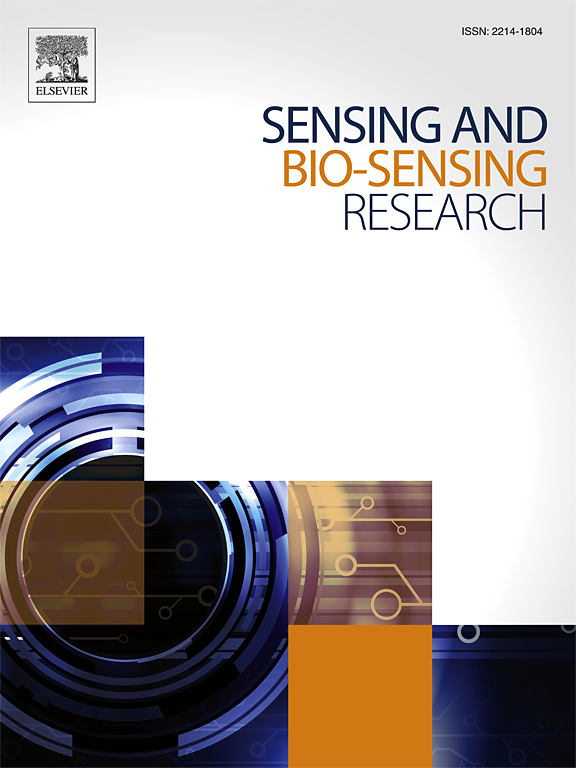High-sensitivity creatine detection using doped ZnO nanoribbon biosensors: A density functional theory approach
IF 5.4
Q1 CHEMISTRY, ANALYTICAL
引用次数: 0
Abstract
Determining creatine concentration in the liver and kidneys is crucial for diagnosing health status due to its role as a significant biomarker in biosynthesis and muscle energy metabolism. This study proposes a two-terminal device made of hydrogen-passivated armchair ZnO nanoribbons connected between ZnO nanoribbon electrodes to explore its potential as a creatine biosensor. Using Transiesta, Tbtrans, and Density Functional Theory (DFT) calculations, the study evaluates the sensing capabilities of doped AZnONR for the first time. It involves hydrogen passivation, detailed doping analysis, and the assessment of electronic structure and adsorption properties to optimize biosensor performance. Measurements of PDOS, transmission coefficient, conductance, charge transfer, and electrostatic potential elucidate detection mechanisms, focusing on Al, Ga, and N doping effects. Findings reveal that creatine adsorption leads to the disappearance of some states near the conduction band edge due to charge transfer from the Al-doped ZnO nanoribbon. The projected density of states and transmission shift to higher energies because of creatine's negative electrostatic gating effect, significantly reducing transmission at 0.7 eV. A gate voltage of 0.7 V drastically alters the device's conductance, enabling creatine detection with 99.9 % sensitivity. The study highlights Al-doped ZnO nanoribbons' potential as highly sensitive creatine biosensors with an adsorption energy of −3.07 eV.
利用掺杂ZnO纳米带生物传感器进行高灵敏度肌酸检测:密度泛函理论方法
测定肝脏和肾脏中的肌酸浓度对于诊断健康状况至关重要,因为它是生物合成和肌肉能量代谢的重要生物标志物。本研究提出了一种由氢钝化扶手状氧化锌纳米带连接在氧化锌纳米带电极之间的双端装置,以探索其作为肌酸生物传感器的潜力。利用Transiesta, Tbtrans和密度泛函理论(DFT)计算,该研究首次评估了掺杂AZnONR的传感能力。它包括氢钝化,详细的掺杂分析,以及电子结构和吸附性能的评估,以优化生物传感器的性能。PDOS、透射系数、电导、电荷转移和静电势的测量阐明了检测机制,重点是Al、Ga和N掺杂效应。结果表明,由于掺杂al纳米带的电荷转移,肌酸吸附导致导带边缘附近的一些状态消失。由于肌酸的负静电门控效应,状态的投射密度和透射率向更高的能量转移,显著降低了0.7 eV的透射率。0.7 V的栅极电压会极大地改变器件的电导,使肌酸检测具有99.9%的灵敏度。该研究强调了al掺杂ZnO纳米带作为高灵敏度肌酸生物传感器的潜力,其吸附能为- 3.07 eV。
本文章由计算机程序翻译,如有差异,请以英文原文为准。
求助全文
约1分钟内获得全文
求助全文
来源期刊

Sensing and Bio-Sensing Research
Engineering-Electrical and Electronic Engineering
CiteScore
10.70
自引率
3.80%
发文量
68
审稿时长
87 days
期刊介绍:
Sensing and Bio-Sensing Research is an open access journal dedicated to the research, design, development, and application of bio-sensing and sensing technologies. The editors will accept research papers, reviews, field trials, and validation studies that are of significant relevance. These submissions should describe new concepts, enhance understanding of the field, or offer insights into the practical application, manufacturing, and commercialization of bio-sensing and sensing technologies.
The journal covers a wide range of topics, including sensing principles and mechanisms, new materials development for transducers and recognition components, fabrication technology, and various types of sensors such as optical, electrochemical, mass-sensitive, gas, biosensors, and more. It also includes environmental, process control, and biomedical applications, signal processing, chemometrics, optoelectronic, mechanical, thermal, and magnetic sensors, as well as interface electronics. Additionally, it covers sensor systems and applications, µTAS (Micro Total Analysis Systems), development of solid-state devices for transducing physical signals, and analytical devices incorporating biological materials.
 求助内容:
求助内容: 应助结果提醒方式:
应助结果提醒方式:


